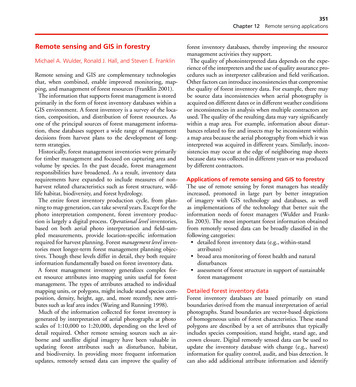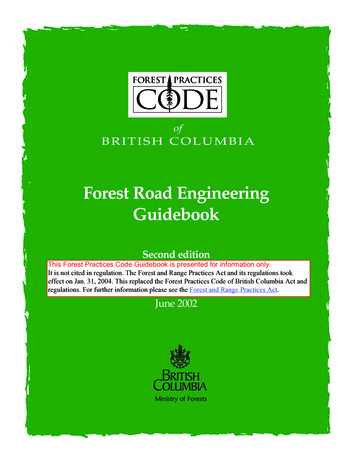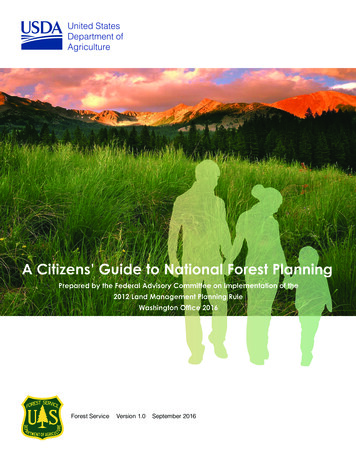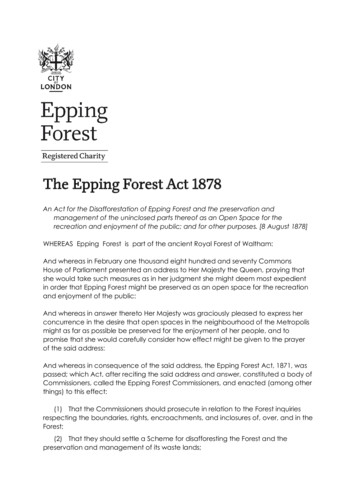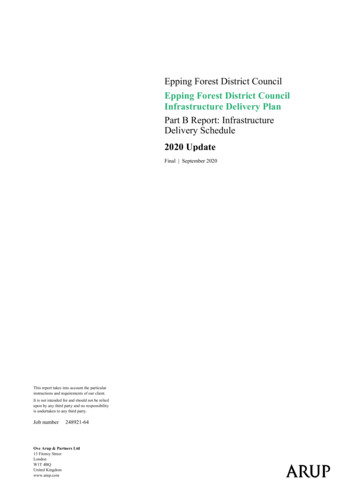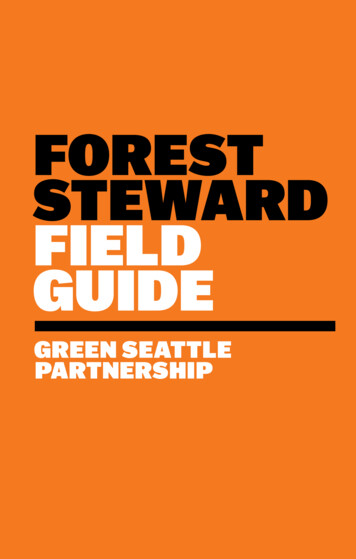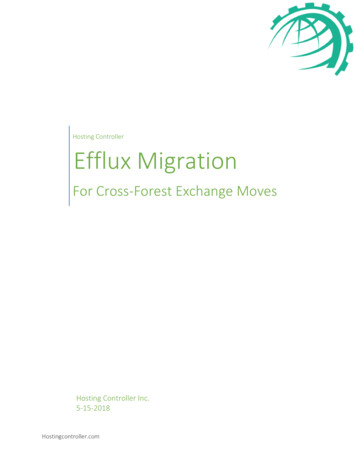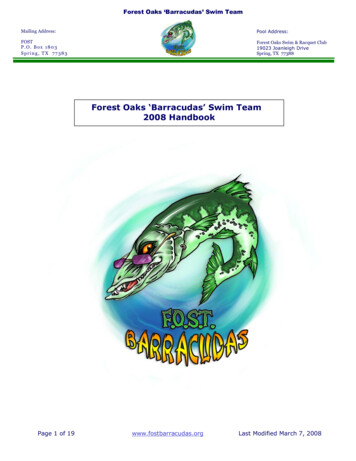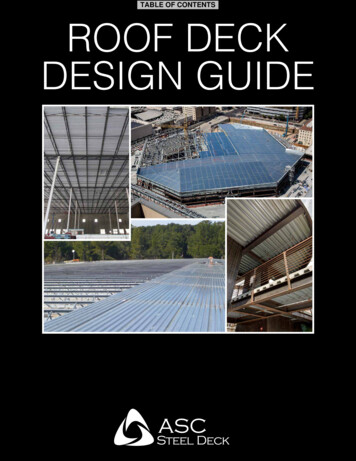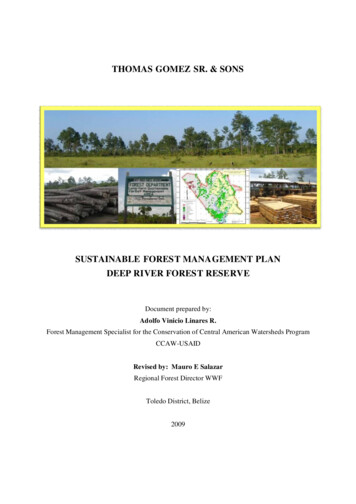
Transcription
THOMAS GOMEZ SR. & SONSSUSTAINABLE FOREST MANAGEMENT PLANDEEP RIVER FOREST RESERVEDocument prepared by:Adolfo Vinicio Linares R.Forest Management Specialist for the Conservation of Central American Watersheds ProgramCCAW-USAIDRevised by: Mauro E SalazarRegional Forest Director WWFToledo District, Belize2009
Table of Contents:1 EXECUTIVE SUMMARY. 12 INTRODUCTION . 23 COMPANY PROFILE . 33.1 Thomas Gomez and Sons. 34 BASIC RESOURCE DATA. 44.1 Legal status of the management area . 44.2 Geographic location of the management area. 44.3 Description of the boundaries of the forest license . 54.4 Physical characteristics of the area. 64.4.1 Topography and hydrology. 64.4.2 Geology and soils . 74.4.3 Climate . 74.4.3.1 Rainfall . 84.4.3.2 Temperature. 94.4.3.3 Relative humidity. 104.4.3.4 Wind. 104.4.4 Special Features. 114.5 Description of the vegetation types . 114.5.1 Savannah . 114.5.1.1 Savannah development and the role of fire . 124.5.2 Mixed Pine/Broadleaved Forest . 134.5.3 Broadleaved Forest. 134.6 Description of the principal fauna . 144.7 Economic environment . 144.7.1 Existing physical infrastructure. 144.7.2 Social infrastructure . 144.7.3 Other resource activities . 165 Objective and strategy of management . 185.2 Strategy. 186 FOREST PLANNING . 196.1 Forest cover classification. 196.2 Production forest. 19Non-production forest. 217 INVENTORY OF FOREST RESOURCES . 217.1 Timber resources-management level inventory. 217.1.1 Type of inventory and sampling design. 217.1.2 Forest inventory results. 247.2 Pre-harvest inventory . 317.3 Post-harvest inventory. 317.4 Non-timber forest resources. 328 SILVICULTURAL SYSTEM . 328.1 Regeneration method. 328.2 Post harvest treatments. 338.3 Supplementary planting and plantation forestry. 348.4 Broadleaved forests Protection . 34i
8.5 Death and over mature trees . 349 GROWTH AND YIELD . 359.1 Growth and forest regulation . 359.2 Calculation of cutting cycle and annual allowable cut. 379.3 Division of the forest into annual harvesting units. 399.4 Schedule of timber production. 4110 TIMBER HARVESTING OPERATIONS . 4110.1 Pre-harvesting activities . 4110.2 Type of machinery. 4210.3 Harvesting activities . 4210.4 Felling operations . 4310.5 Extraction/skidding operations . 4310.6 Hauling operations. 4410.7 Post-harvesting activities . 4410.8 Environmental considerations in logging . 4511 NON TIMBER HARVESTING OPERATIONS . 4512 OTHER GOODS AND SERVICES. 4612.1 Tourism Potential . 4613 MARKETS AND UTILIZATION . 4713.1 Expected products . 4713.2 Industrialization . 4713.3 Marketing, including demands and constraints . 4714 ROADING OPERATIONS. 4814.1 General road network . 4814.2 Roads requirements . 4914.3 Standards of construction and maintenance. 4915 ENVIRONMENTAL CONSERVATION MEASURES. 5015.1 Buffer zones . 5015.2 Wildlife conservation . 5115.3 Use of chemicals. 5115.4 Bio-diversity conservation . 5215.5 Soil and water conservation . 5216 MONITORING AND RESEARCH . 5916.1 Previous and Current Research. 5916.2 Proposals for experimental or permanent sample plots . 6016.3 Current Research Activities and Sites. 6216.4 Plans for monitoring effects of logging and/or other forest management activities . 6216.5 Cooperation with research organizations. 6216.6 Other Research Interests . 6217 FACTORS INFLUENCING SFM AND PROPOSED SOLUTIONS . 6317.1 Biophysical conditions . 6317.2 Markets, industrialization. 6417.3 Social conditions. 6517.4 Resource use conflicts. 6618 FOREST PROTECTION . 6718.1 Security and Vigilance Plan. 67ii
18.2 Integrated pest management plan . 6918.3 Fire management . 7019 INFORMATION MANAGEMENT SYSTEM. 7220 SCHEDULE FOR IMPLEMENTATION OF ACTIVITIES . 7321 REFERENCES. 7522 APPENDIXES . 77Table 1. Average annual rainfall at five stations near the management area . 8Table 2. Average daily temperatures at five stations near the management area. 9Table 3. Mean annual relative humidity at two stations. 10Table 4. Major hurricanes that have affected Belize during the period 1931 – 2000. 10Table 5. Population of villages near the management area: 2000 . 15Table 6. Population by ethnicity (%) for Stann Creek and Toledo: 1991 and 2000. 16Table 7. Deep River Forest Reserve Land Cover areas. 21Table 8. Number of pine stems per hectare by size class. . 25Table 9. Height Regression Models . 25Table 10. Statistical Analysis of the pine volume estimates and forest inventory. 26Table 11. Stem density and volume per hectare for Pine according to diameter class. 27Table 12. Pine Stem density and volume per hectare Inverse Cumulative Average. 27Table 13. Pine Productive Forest Stratification Compartments . 30Table 14. Diameter growth analysis for the Deep River Forest Reserve . 35Table 15. Basal area growth projection analysis for the Deep River Forest Reserve . 36Table 16. Calculations of Periodic Volume Growth by Stand Table Projection . 37Table 17. Annual Allowable Cut for the TGS FMU. 38Table 18. Annual Harvesting Scenarios for TGS FMU . 39Table 19. Annual Harvesting Blocks for 2010-2014 . 39Table 20. Description of the Program for corrective-preventive action. 53Table 21. Activities to be developed within the first five-year period after launching SFMP73Figure 1. Average monthly precipitation for several sites within or close to the Management Area . 8Figure 2. Average daily temperature for several sites within and near the Management Area . 9Figure 3. Human Population Growth in Southern Belize. 16Figure 4. Spaniard Regression Model Calculation for DBH Height . 26Figure 5. Pine Frequency and Volume distribution comparison. 28Figure 6. TGS-4 Inverse Cumulative Distribution. 28Map1: Location of the Thomas Gomez & Sons Forest Management Unit . 5Map 2. Deep River Forest Reserve Land Cover . 20Map 3. Forest Inventory Sampling Plots Distribution . 23Map 4. Pine Productive Forest Stratification Compartments. 30Map 5. Annual Harvesting Blocks for the years 2010-2014. . 40Map 6. Primary and secondary roads for the Deep River Forest Reserve. 48iii
STFAPTIDETWDUBYLLAnnual plan of operationsBelize Agricultural Health AuthorityCutting cycleCentre for Development of EnterpriseDiameter at breast heightForest DepartmentForest ReserveForest Stewardship CouncilGovernment of BelizeGrants Works Forest ReserveHectareInter American Development BankIntegrated Pest Managementkiln driedLand Information CentreLesser known species (hardwoods)Land and Surveys DepartmentMinimum cutting diameterMinistry of Natural Resources and the EnvironmentMountain pine ridgeNon timber forest productsOver BarkPermanent sample plotRio Bravo Conservation and Management AreaReduced impact loggingSouthern Coastal PlainSustainable forest managementSustainable forest management planThomas Gomez and SonsTropical Forest Action PlanToledo Institute for Development and the EnvironmentThe Wood DepotUnder BarkYong Lumber Ltd.iv
Thomas Gomez Sr. & Sons1Deep River Forest Reserve SFMPEXECUTI VE SUMMARYIn the past years the Government of Belize has granted nearly 150,000 hectares of tropical forest tothe country’s forest industry. However, strong efforts are needed towards ensuring responsibleforest management and natural resources sustainability. Most Forest Management Units rotationcycles have been estimated without proper research and monitoring of forest response to currentharvesting practices and regeneration. Under this scenario both forest integrity and sustainabilitydemand on more attention to ensure that Sustainable Forest Management principles areaccomplished.To address these issues, the Conservation of Central America Watersheds Program, CCAW; anUSAID sponsored project provided support to one of the pioneer forest industry in southern Belize,managed by Mr. Thomas Gomez & Sons. Primarily, an evaluation of the management plan wascarried out to determine the level of application of sustainable practices, and also to evaluate thefeasibility of the former stated rotation cycle, according to the forest natural regeneration and theindustry round timber annual demand. As per these preliminary analyses, it was determined thatstrong adjustments were demanded to update Mr. Thomas Gomez and Sons management plan, andtherefore a general forest inventory was performed from April to June 2009 using the PROCAFORregional methodology for pine forests. No major analysis were conducted in the remainingbroadleaf species patches, since severe past harvests have reduced them to shrubby forest that are ina naturally recovery process.From the supervised classification of the SPOT satellite image, the production forests within thedefined FMU area was estimated as to 5,587.5 ha (26.3%) of the total area (21,294 ha). However,it was observed during the forest inventory that pine interacts with savannah and broadleavedareas. The final Pine stratification considered some of this area, only where sampling plots tookplace to verify pine existence, ascending the productive pine forests to 6,090.45 ha. Productionforests are located on lands without biophysical limitations, such as steep slopes, unstable soils orendangered ecosystems.The final general forest inventory data analysis and updated rotation cycle yield an estimated annualharvesting of 2,500m3 of logs in approximately 200 ha of pine forest every year in a rotation cycleof 30 years with a 30 cm MCD. The area does not have to be fixed, since the 2,500m3 could beharvested in less area, leaving area for next year’s APO. In other words, the compartments areformed by volume and not by area. The estimated volume of total available timber in the licensearea is about 256,389m3; which is all pine (Pinus Caribaea). The estimated annual volume growthof 0.7037 m3/ha for pine will allow for a felling cycle of 30 years based on the envisaged productionof 450,000 board feet per year. No figures exist for hardwoods; most of trees affected by hurricanehave already been salvaged. Damage from Hurricane Iris especially to the broadleaf forest has beenextremely severe.This management plan was prepared using proved methodology that WWF has applied throughoutLatin America, and thus all pre-harvesting, harvesting and post-harvesting activities wereconsidered to ensure that no considerable damages are caused to forest ecosystems integrity duringthe harvesting stage.1
Thomas Gomez Sr. & Sons2Deep River Forest Reserve SFMPINTRODUCTI ONAs part of the USAID’s Conservation of Central American Watersheds Program, Thomas Gomez &Sons has received technical and professional assistance in order to improve their environmental andbusiness management performance. The grant “Promoting forest certification standards, as a toolfor ensuring responsible forest management and trade within the forest industry in Belize.” hashelped to strengthen forest management activities; along with administration and businessmanagement of TGS.TGS is a family owned business managing the Deep River Forest Reserve under a 40 yearconcession as part of the Forest License LTFL 1/05 assigned by the government. Previously, TGShad a Sustainable Forest Management Plan with a unique structure that included three differentcompanies (TGS, YL and TWD), managing 74,227 ha in five different areas of the southern coastalplains. The 17.9% (13,290 ha / 32,826 acres) of the area under license and management belongs toTGS; and was set under a 10-year rotation cycle according to the SFMP approved by the ForestDepartment.The present plan is an update of the previous SFMP in order to include additional forest area to theSFM scheme. Also, enhance the forest type classification mechanism used in the previous plan thatlacked a proper stratification or ground survey; and finally, determine a more certain timber yieldfor business purposes of adding value to the timber production. The TGS SFMP update will allowsecuring a constant timber production by establishing more equitable harvesting compartments forpine production.After carrying on a supervised classification and a ground survey of the pine forest (Chapter 6), asystematic forest inventory with 0.46% intensity was implemented (chapter 7). The information wasgathered using the PROCAFOR methodology with 1000m2 circular plots consisting of DBH( 10cm), Total Height, age, increment, bark, soil type, fuel type, slope and any other characteristicsrelevant for management purposes. The results of the inventory are discussed in chapter 7 andprovide information to determine the different scenarios that could take place with different rotationcycles, annual allowable cut and harvesting compartments (chapter 9).The rest of the SFMP document has a general description of the company (chapter 3) and the entireFMU area (chapter 4). It continues with a description of the objectives and management strategy(chapter 5). Chapter 8 describes the entire sylvicultural system with the different regenerationmethods and post harvesting treatments. The rest of the chapters (10-20) continue to describe thedifferent operations in relation to harvesting, non timber forest products, markets, roads,environmental services, environmental conservation measures, monitoring and research, forestprotection, information management and finally a schedule to implement all the different activities;with the sole objective of having a Sustainable Forest Management process for the TGS FMU.The update of the SFMP for the TGS FMU has required great effort, being the result of a jointendeavor among personnel from TGS and CCAW. The present plan set the base for a propersustainable forest management scheme to be implemented by TGS for the next 30 years. TGS willcontinue their pioneering process in setting a precedent of SFM being implemented by a privatecompany; and will allow the Forest Department and others to continue supporting such a difficulttask of consolidating SFM in Belize.2
Thomas Gomez Sr. & SonsDeep River Forest Reserve SFMP3 COMPANY PROFILE3.1 Thomas Gomez and SonsThomas Gomez and Sons (TGS) was registered as a company in 1995. TGS is currently one of theoldest operating licensees on the Southern Coastal Plain (SCP). Mr. Gomez started to work theSouthern half of the Deep River Forest Reserve east of Deep River in 1989 when he beganextracting power poles and piles for the Wood Depot. In 1995 Tomas Gomez and Sons started toproduce lumber from both hardwoods and pine.Currently, TGS continues to produce planed and rough pine and hardwood lumber. It has twooutlets, one in Punta Gorda and another in Belize City.TGS has expressed an interest in a long term SFM license since 1998 and is currently licensee to a40-year contract to manage the Deep River Forest Reserve. TGS is in their fourth year of workingunder SFM criteria and a SFMP plan prepared together with Young Lumber and The Wood Depot.The production base of the company consists of:·The extension of the Long Term Forest License LTF-05 was updated to 21,243.9 ha(52472.47acres) after adding 7,954 ha, located to the west of the Deep River, to its initial 13,290hectare granted.·Existing logging operations, consists of 1 team equipped with D-4 bulldozer, 2 skidders, 2loaders, rubber wheeled tractors, 2 towheads with logging trailers. It is capable of quicklyfielding an additional logging team. The company also has a small excavator, backhoe, anddump truck, and an adapted grader blade. TGS employs altogether 24 employees.·The existing sawmills3o Current milling capacity: 5 m /day (2,100 bf/day). Occasionally 3,000 bf/ day.o The estimated volume of total available timber in the license area is about 256,389m3;which is all pine. No figures exist for hardwoods; most of trees affected by hurricanehave already been salvaged. Damage from Hurricane Iris especially to the broadleafforest has been extremely severe.·The estimated annual volume growth of 0.7037 m3/ha for pine will allow for a felling cycle of30 years based on the envisaged production of 450,000 bf/yr.·The current (and planned) input needs of the company are 2,543 m3 of logs per year. Theseneeds are satisfied with the company’s license resource according to the calculated annualallowable cut of 4,263 m3/yr. As the company consolidates and the forest stands are regulated,more volume of the annual allowable cut could be harvested.·Planned downstream processing includes Molding to utilize lumber with a limited marketdemand.3
Thomas Gomez Sr. & SonsDeep River Forest Reserve SFMP4 BASIC RESOURCE DAT A4.1 Legal status of the management areaThe rights and responsibilities of the licensee are as described in their license agreement. The areacovered by this management plan is located in the Southern Coastal Plain area of Belize (south) inthe Deep River Forest ReserveForest Reserves are national extractive reserves declared by the Minister responsible for Forestrythrough a Statutory Instrument under the Forest Act and are considered protected areas. Theextraction of most natural resources (timber, minerals, wildlife, and water) in forest reserves ispermitted as well as their use for recreation and tourism. Temporary cultivation traditionally relatedto the subsistence of persons engaged in a permitted extraction activity within the forest reserve isalso allowed but no permanent agricultural crops may be planted. Licensees and their employeesare normally allowed to camp or reside in a forest reserve and to erect such structures as arerequired for habitation, the processing of timber, and other ancillary activities with theunderstanding that these structures must be removed once the license or permit expires or isrevoked. There are four forest reserves, which are encompassed in the SCP area, namely, MangoCreek Forest Reserve no. 1, Mango Creek Forest Reserve no. 4, Swasey Bladen Forest Reserve, andDeep River Forest Reserve.Deep River Forest Reserve was originally gazetted in 1941 with an area of 98,496 acres. In 1990 thenorthern part of the reserve was re-designated under the National Parks System Act as part of theBladen Nature Reserve. Numerous agricultural excisions from the forest reserve have been made,all without due recourse to appropriate de-reservation procedures. The justification for itsdesignation as a forest reserve was to enable protection and manage the exploitation of mahoganyand pine. The present estimated area of the Deep River Forest Reserve is 67,304.8 acres (27,237.4ha) (Meerman, 2005).4.2 Geographic location of the management areaThe management area is located in the Toledo District on the Southern Highway 70 km away fromPunta Gorda.The largest urban area is Independence, which is approximately 160 km from Belmopan, 240 kmfrom Belize City and 80 km from Stann Creek Town. The port of Big Creek adjoins it. There is asmall forest station at Savannah, 5 km from Independence, responsible for the regular oversight ofthe logging quota of TGS, particularly in terms of scaling of logs.4
Thomas Gomez Sr. & SonsDeep River Forest Reserve SFMPMap1: Location of the Thomas Gomez & Sons Fo
THOMAS GOMEZ SR. & SONS SUSTAINABLE FOREST MANAGEMENT PLAN DEEP RIVER FOREST RESERVE Document prepared by: Adolfo Vinicio Linares R. Forest Management Specialist for the Conservation of Central American Watersheds Program CCAW-USAID Revised by: Mauro E Salazar Regional Forest Director WWF Toledo District, Belize 2009
